The global antibacterial hydrophilic aluminum foil market is valued at USD 246.8 million in 2025 and is set to reach USD 405.8 million by 2035, recording an absolute increase of USD 159.0 million over the forecast period. This translates into a total growth of 64.4%, with the market forecast to expand at a compound annual growth rate (CAGR) of 5.10% between 2025 and 2035.
The overall market size is expected to grow by approximately 1.6X during the same period, supported by increasing demand for hygienic coating solutions, growing adoption of antimicrobial surface technologies, and rising requirements for advanced heat exchange systems across HVAC, refrigeration, medical equipment, and household appliances sectors.
Between 2025 and 2030, the antibacterial hydrophilic aluminum foil market is projected to expand from USD 246.8 million to USD 316.5 million, resulting in a value increase of USD 69.7 million, which represents 43.8% of the total forecast growth for the decade.
This phase of development will be shaped by increasing demand for antimicrobial surface solutions, rising HVAC efficiency consciousness enabling advanced heat exchanger technologies, and growing availability of specialized coating processes across air conditioning systems and refrigeration equipment.
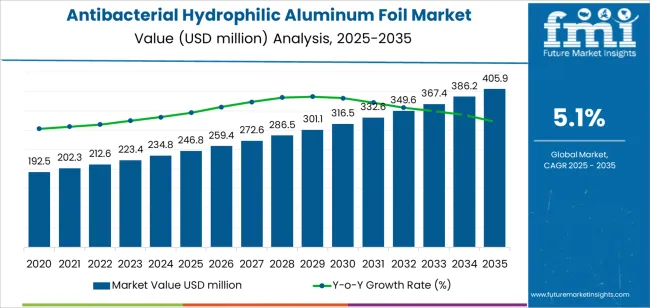
Between 2030 and 2035, the market is forecast to grow from USD 316.5 million to USD 405.8 million, adding another USD 89.3 million, which constitutes 56.2% of the overall ten-year expansion. This period is expected to be characterized by the advancement of enhanced antibacterial formulations, the integration of nanotechnology for superior performance, and the development of premium hydrophilic coatings across diverse thermal management applications. The growing emphasis on indoor air quality optimization and energy efficiency enhancement will drive demand for advanced foil varieties with enhanced antimicrobial efficacy, improved durability characteristics, and superior heat transfer profiles.
Between 2020 and 2024, the antibacterial hydrophilic aluminum foil market experienced steady growth, driven by increasing awareness of hygiene requirements and growing recognition of hydrophilic technology's effectiveness in delivering superior heat exchange efficiency across residential and commercial HVAC applications. The market developed as manufacturers recognized the potential for advanced antimicrobial coatings to deliver operational efficiency while meeting modern requirements for indoor air quality and high-performance thermal management systems. Technological advancement in surface treatment processes and antibacterial agent integration began emphasizing the critical importance of maintaining heat transfer effectiveness while enhancing microbial resistance and improving long-term performance reliability.
| Metric | Value |
|---|---|
| Estimated Value in (2025E) | USD 246.8 million |
| Forecast Value in (2035F) | USD 405.8 million |
| Forecast CAGR (2025 to 2035) | 5.10% |
From 2030 to 2035, the market is forecast to grow from USD 316.5 million to USD 405.8 million, adding another USD 89.3 million, which constitutes 56.2% of the overall ten-year expansion. This period is expected to be characterized by the advancement of enhanced nano-coating technologies, the integration of smart antimicrobial release systems for sustained protection, and the development of specialized surface textures for optimized condensate management. The growing emphasis on energy efficiency and microbial control will drive demand for premium varieties with enhanced bactericidal credentials, improved corrosion resistance options, and superior thermal conductivity characteristics.
Between 2020 and 2024, the antibacterial hydrophilic aluminum foil market experienced robust growth, driven by increasing awareness of hygiene benefits and growing recognition of hydrophilic systems' effectiveness in supporting efficient heat exchange operations across medical facilities and food processing equipment. The market developed as users recognized the potential for specialized antimicrobial coatings to deliver performance advantages while meeting modern requirements for consistent thermal efficiency and reliable contamination control. Technological advancement in coating application processes and quality assurance systems began emphasizing the critical importance of maintaining surface integrity while extending antimicrobial service life and improving customer satisfaction across diverse thermal management applications.
Market expansion is being supported by the increasing global demand for hygienic thermal solutions and the corresponding shift toward high-performance antimicrobial coatings that can provide superior operational characteristics while meeting user requirements for enhanced indoor air quality and cost-effective maintenance processes. Modern HVAC manufacturers are increasingly focused on incorporating antimicrobial systems that can enhance heat transfer efficiency while satisfying demands for consistent, precisely controlled condensate drainage and optimized energy consumption practices. Antibacterial hydrophilic aluminum foil's proven ability to deliver thermal efficiency, microbial protection, and diverse application possibilities makes them essential components for equipment manufacturers and quality-conscious system integrators.
The growing emphasis on hygiene standards and energy optimization is driving demand for high-performance antimicrobial foil systems that can support distinctive thermal outcomes and comprehensive contamination prevention across residential HVAC, commercial refrigeration, and medical equipment applications. User preference for materials that combine functional excellence with health protection is creating opportunities for innovative implementations in both traditional and emerging thermal management applications. The rising influence of smart building technologies and advanced HVAC systems is also contributing to increased adoption of specialized antimicrobial foils that can provide authentic performance benefits and reliable hygienic characteristics.
The market is segmented by product type, application, coating thickness, surface treatment, end-user industry, and region. By product type, the market is divided into ordinary type, high corrosion resistance type, enhanced antibacterial type, premium hydrophilic type, and others. Based on application, the market is categorized into household appliances, medical equipment, HVAC systems, refrigeration equipment, and others. By coating thickness, the market includes standard coating (5-10 microns), medium coating (10 to 20 microns), thick coating (20-30 microns), and ultra-thick coating (30+ microns).
By surface treatment, the market encompasses standard hydrophilic treatment, enhanced antibacterial coating, nano-structured surface, and multi-layer protection systems. By end-user industry, the market covers residential sector, commercial sector, healthcare sector, and industrial sector. Regionally, the market is divided into North America, Europe, Asia Pacific, Latin America, Middle East & Africa, and other regions.
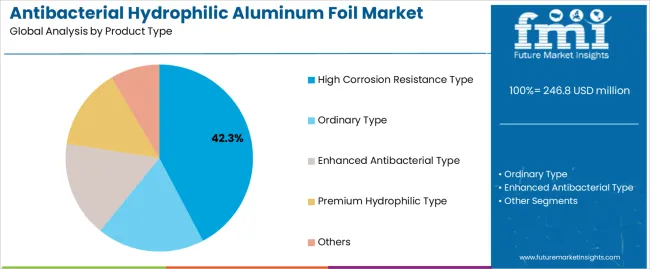
The high corrosion resistance type segment is projected to account for 42.3% of the antibacterial hydrophilic aluminum foil market in 2025, reaffirming its position as the leading product category. HVAC manufacturers and equipment professionals increasingly utilize high corrosion resistance types for their superior durability characteristics, established reliability standards, and essential functionality in diverse thermal applications across multiple equipment types. High corrosion resistance types' proven performance characteristics and established cost-effectiveness directly address user requirements for reliable equipment operation and optimal heat transfer efficiency in commercial applications.
This product segment forms the foundation of modern thermal management performance patterns, as it represents the component category with the greatest operational impact potential and established compatibility across multiple HVAC systems. Business investments in advanced coating technology and performance optimization continue to strengthen adoption among efficiency-conscious manufacturers. With users prioritizing thermal consistency and equipment longevity, high corrosion resistance types align with both performance objectives and durability requirements, making them the central component of comprehensive thermal management strategies.
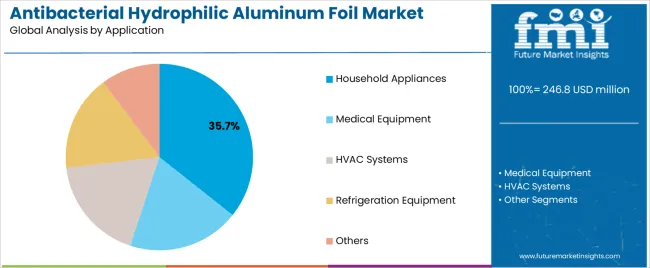
Household appliances is projected to represent 35.7% of the antibacterial hydrophilic aluminum foil market in 2025, underscoring its critical role as the primary application for quality-focused manufacturers seeking superior thermal efficiency benefits and enhanced product performance credentials. Appliance manufacturers and system designers prefer household applications for their established market volumes, proven consumer demand, and ability to maintain exceptional heat transfer quality while supporting versatile thermal requirements during diverse residential applications. Positioned as essential applications for performance-conscious manufacturers, household offerings provide both operational excellence and competitive positioning advantages.
The segment is supported by continuous improvement in thermal technology and the widespread availability of established efficiency standards that enable quality assurance and premium positioning at the manufacturer level. Additionally, appliance companies are optimizing material selections to support product differentiation and competitive pricing strategies. As thermal technology continues to advance and manufacturers seek efficient heat exchange methods, household applications will continue to drive market growth while supporting business development and consumer satisfaction strategies.
The antibacterial hydrophilic aluminum foil market is advancing rapidly due to increasing hygiene consciousness and growing need for enhanced thermal solutions that emphasize superior performance outcomes across residential segments and commercial applications. However, the market faces challenges, including competition from alternative coating technologies, material cost pressures, and manufacturing complexity affecting operational economics. Innovation in nano-coating integration and advanced surface treatments continues to influence market development and expansion patterns.
Expansion of HVAC and Refrigeration Applications
The growing adoption of antibacterial hydrophilic aluminum foil in HVAC systems and refrigeration equipment is enabling manufacturers to develop thermal strategies that provide distinctive efficiency benefits while commanding competitive positioning and enhanced product performance characteristics. HVAC applications provide superior heat transfer consistency while allowing more sophisticated condensate management features across various equipment categories. Users are increasingly recognizing the operational advantages of antimicrobial positioning for premium thermal outcomes and efficiency-conscious system integration.
Integration of Nanotechnology and Advanced Surface Treatments
Modern antibacterial hydrophilic aluminum foil manufacturers are incorporating advanced nanotechnology, enhanced surface modification systems, and smart antimicrobial release mechanisms to enhance thermal precision, improve coating longevity, and meet commercial demands for intelligent thermal solutions. These systems improve operational effectiveness while enabling new applications, including predictive maintenance programs and performance optimization protocols. Advanced nanotechnology integration also allows manufacturers to support innovation leadership positioning and quality assurance beyond traditional thermal management operations.
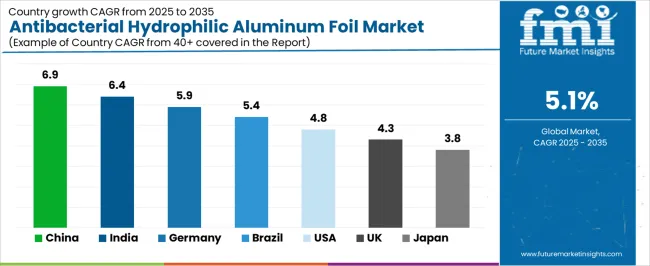
| Country | CAGR (2025 to 2035) |
|---|---|
| China | 6.9% |
| India | 6.4% |
| Germany | 5.9% |
| Brazil | 5.4% |
| USA | 4.8% |
| UK | 4.3% |
| Japan | 3.8% |
The antibacterial hydrophilic aluminum foil market is experiencing robust growth globally, with China leading at a 6.9% CAGR through 2035, driven by the expanding HVAC manufacturing industry, growing residential construction requirements, and increasing adoption of energy-efficient thermal systems. India follows at 6.4%, supported by rising infrastructure development, expanding appliance manufacturing sector, and growing acceptance of antimicrobial thermal solutions. Germany shows growth at 5.9%, emphasizing established manufacturing capabilities and comprehensive thermal technology development. Brazil records 5.4%, focusing on residential expansion and commercial equipment growth. The USA demonstrates 4.8% growth, prioritizing advanced thermal technologies and equipment optimization.
The report covers an in-depth analysis of 40+ countries, the top-performing countries are highlighted below.
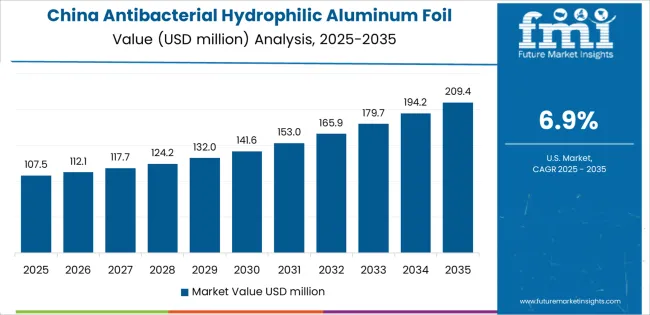
Revenue from antibacterial hydrophilic aluminum foil consumption and sales in China is projected to exhibit exceptional growth with a CAGR of 6.9% through 2035, driven by the country's rapidly expanding HVAC manufacturing sector, favorable government policies toward energy efficiency development, and initiatives promoting advanced thermal technologies across major industrial regions. China's position as a leading appliance manufacturing hub and increasing focus on antimicrobial coating systems are creating substantial demand for high-quality antibacterial hydrophilic aluminum foil in both domestic and export markets. Major equipment manufacturers and thermal system companies are establishing comprehensive material capabilities to serve growing demand and emerging market opportunities.
Revenue from antibacterial hydrophilic aluminum foil products in India is expanding at a CAGR of 6.4%, supported by rising infrastructure investment, growing appliance manufacturing development, and expanding thermal system capabilities. The country's developing manufacturing sector and increasing commercial investment in advanced thermal technologies are driving demand for antibacterial hydrophilic aluminum foil across both traditional and modern thermal applications. International material companies and domestic suppliers are establishing comprehensive operational networks to address growing market demand for quality antimicrobial materials and efficient thermal solutions.
Revenue from antibacterial hydrophilic aluminum foil products in Germany is projected to grow at a CAGR of 5.9% through 2035, supported by the country's mature manufacturing sector, established thermal standards, and leadership in equipment technology. Germany's sophisticated industrial infrastructure and strong support for advanced thermal systems are creating steady demand for both traditional and innovative antimicrobial material varieties. Leading equipment manufacturers and specialty suppliers are establishing comprehensive operational strategies to serve both domestic markets and growing export opportunities.
Revenue from antibacterial hydrophilic aluminum foil products in Brazil is projected to grow at a CAGR of 5.4% through 2035, driven by the country's emphasis on appliance manufacturing expansion, residential development, and growing thermal system capabilities. Brazilian manufacturers and equipment companies consistently seek commercial-grade materials that enhance product efficiency and support operational excellence for both traditional and modern thermal applications. The country's position as a Latin American manufacturing leader continues to drive innovation in specialized antimicrobial applications and commercial equipment standards.
Revenue from antibacterial hydrophilic aluminum foil products in the USA is projected to grow at a CAGR of 4.8% through 2035, supported by the country's emphasis on thermal technology advancement, equipment optimization, and advanced hygiene integration requiring efficient antimicrobial solutions. American manufacturers and industrial users prioritize performance reliability and operational precision, making specialized antimicrobial materials essential components for both traditional and modern thermal applications. The country's comprehensive technology leadership and advancing thermal patterns support continued market expansion.
Revenue from antibacterial hydrophilic aluminum foil products in the UK is projected to grow at a CAGR of 4.3% through 2035, supported by established thermal standards, mature manufacturing markets, and emphasis on equipment reliability across commercial and residential sectors. British manufacturers and thermal professionals prioritize quality performance and operational consistency, creating steady demand for premium antimicrobial material solutions. The country's comprehensive market maturity and established thermal practices support continued development in specialized applications.
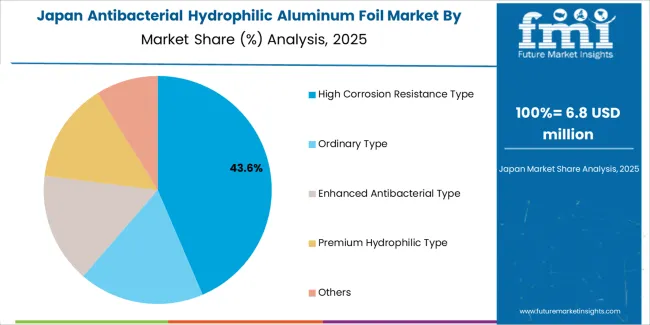
Revenue from antibacterial hydrophilic aluminum foil products in Japan is projected to grow at a CAGR of 3.8% through 2035, supported by the country's emphasis on precision manufacturing, quality excellence, and advanced technology integration requiring efficient antimicrobial solutions. Japanese businesses and industrial users prioritize technical performance and manufacturing precision, making specialized antimicrobial materials essential components for both traditional and modern thermal applications. The country's comprehensive quality leadership and advancing thermal patterns support continued market expansion.
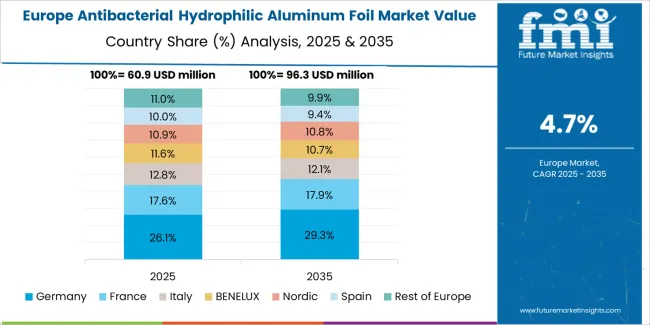
The Europe antibacterial hydrophilic aluminum foil market is projected to grow from USD 72.2 million in 2025 to USD 133.9 million by 2035, recording a CAGR of 5.1% over the forecast period. Germany leads the region with a 36.4% share in 2025, moderating slightly to 36.0% by 2035, supported by its strong industrial base and demand for premium, technically advanced thermal management materials. The United Kingdom follows with 23.8% in 2025, easing to 23.4% by 2035, driven by a mature appliance market and emphasis on equipment reliability and performance optimization.
France accounts for 15.7% in 2025, rising to 16.2% by 2035, reflecting steady adoption of antimicrobial thermal solutions and operational efficiency enhancement. Italy holds 11.9% in 2025, expanding to 12.5% by 2035 as HVAC manufacturing and specialty thermal applications grow.
Spain contributes 7.2% in 2025, growing to 7.5% by 2035, supported by expanding construction sector and equipment modernization. The Nordic countries rise from 3.6% in 2025 to 3.8% by 2035 on the back of strong technology adoption and advanced thermal methodologies. BENELUX remains at 1.4% share across both 2025 and 2035, reflecting mature, efficiency-focused industrial markets.
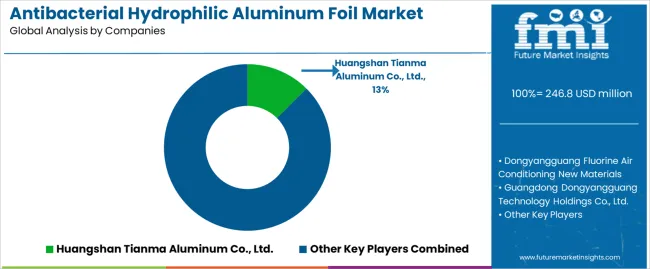
The antibacterial hydrophilic aluminum foil market is characterized by competition among established aluminum manufacturers, specialized coating companies, and integrated thermal solution providers. Companies are investing in advanced surface treatment technologies, antimicrobial coating development systems, product innovation capabilities, and comprehensive distribution networks to deliver consistent, high-quality, and reliable antibacterial hydrophilic aluminum foil systems. Innovation in antimicrobial efficacy enhancement, thermal conductivity optimization, and application-specific product development is central to strengthening market position and customer satisfaction.
Huangshan TianmaAluminum Co., Ltd. leads the market with a strong focus on aluminum processing innovation and comprehensive antibacterial hydrophilic foil solutions, offering commercial material systems with emphasis on manufacturing excellence and technological heritage. Dongyangguang Fluorine Air Conditioning New Materials provides specialized thermal materials with a focus on HVAC market applications and performance engineering networks. Guangdong Dongyangguang Technology Holdings Co., Ltd. delivers integrated thermal solutions with a focus on manufacturer positioning and operational efficiency. Anhui Jinyu Materials Co., Ltd. specializes in comprehensive aluminum processing with an emphasis on antimicrobial applications. Shanghai Metal Corporation focuses on comprehensive industrial materials with advanced processing and premium positioning capabilities.
The success of antibacterial hydrophilic aluminum foil in meeting commercial thermal demands, manufacturer-driven efficiency requirements, and hygiene integration will not only enhance thermal management outcomes but also strengthen global materials manufacturing capabilities. It will consolidate emerging regions' positions as hubs for efficient material production and align advanced economies with commercial thermal systems. This calls for a concerted effort by all stakeholders -- governments, industry bodies, manufacturers, distributors, and investors. Each can be a crucial enabler in preparing the market for its next phase of growth.
| Items | Values |
|---|---|
| Quantitative Units (2025) | USD 246.8 million |
| Product Type | Ordinary Type, High Corrosion Resistance Type, Enhanced Antibacterial Type, Premium Hydrophilic Type, Others |
| Application | Household Appliances, Medical Equipment, HVAC Systems, Refrigeration Equipment, Others |
| Coating Thickness | Standard Coating (5-10 microns), Medium Coating (10 to 20 microns), Thick Coating (20-30 microns), Ultra-Thick Coating (30+ microns) |
| Surface Treatment | Standard Hydrophilic Treatment, Enhanced Antibacterial Coating, Nano-Structured Surface, Multi-Layer Protection Systems |
| End-User Industry | Residential Sector, Commercial Sector, Healthcare Sector, Industrial Sector |
| Regions Covered | North America, Europe, Asia Pacific, Latin America, Middle East & Africa, Other Regions |
| Countries Covered | China, India, Germany, Brazil, United States, United Kingdom, Japan, and 40+ countries |
| Key Companies Profiled | Huangshan Tianma Aluminum Co., Ltd., Dongyangguang Fluorine Air Conditioning New Materials, Guangdong Dongyangguang Technology Holdings Co., Ltd., and other leading antibacterial hydrophilic aluminum foil companies |
| Additional Attributes | Dollar sales by product type, application, coating thickness, surface treatment, end-user industry, and region; regional demand trends, competitive landscape, technological advancements in surface treatment engineering, antimicrobial coating initiatives, thermal optimization programs, and premium product development strategies |
The global antibacterial hydrophilic aluminum foil market is estimated to be valued at USD 246.8 million in 2025.
The market size for the antibacterial hydrophilic aluminum foil market is projected to reach USD 405.9 million by 2035.
The antibacterial hydrophilic aluminum foil market is expected to grow at a 5.1% CAGR between 2025 and 2035.
The key product types in antibacterial hydrophilic aluminum foil market are high corrosion resistance type, ordinary type, enhanced antibacterial type, premium hydrophilic type and others.
In terms of application, household appliances segment to command 35.7% share in the antibacterial hydrophilic aluminum foil market in 2025.






Full Research Suite comprises of:
Market outlook & trends analysis
Interviews & case studies
Strategic recommendations
Vendor profiles & capabilities analysis
5-year forecasts
8 regions and 60+ country-level data splits
Market segment data splits
12 months of continuous data updates
DELIVERED AS:
PDF EXCEL ONLINE
Antibacterial Finishes Market Size and Share Forecast Outlook 2025 to 2035
Antibacterial Haemostatic Gels Market - Trends & Forecast 2025 to 2035
Urinary Antibacterial & Antiseptic Pharmaceuticals Market Analysis – Forecast 2025 to 2035
Hydrophilic Coating Market Size and Share Forecast Outlook 2025 to 2035
Foil Embossing Machine Market Size and Share Forecast Outlook 2025 to 2035
Foil Pouch Packaging Market Size and Share Forecast Outlook 2025 to 2035
Foil Laminates Market Size and Share Forecast Outlook 2025 to 2035
Market Positioning & Share in the Foil Laminates Sector
Market Share Breakdown of Foil Labels Manufacturers
Foil Labels Market Analysis by Metal Foils & Polymer-Based Foils Through 2035
Foil Tapes Market
Foil Zipper Bags Market
Multi-foil Rotor Market Analysis - Size, Share, and Forecast Outlook 2025 to 2035
Evaluating Metal Foil Tapes Market Share & Provider Insights
Copper Foil Rolling Mill Market Forecast and Outlook 2025 to 2035
Coding Foils & Tapes Market Size and Share Forecast Outlook 2025 to 2035
Inline Foil Punch and Seal Machines Market Size and Share Forecast Outlook 2025 to 2035
Copper Foil Market Growth - Trends & Forecast 2025 to 2035
Market Share Insights of Coding Foils & Tapes Providers
Tipping Foils Market Size and Share Forecast Outlook 2025 to 2035

Thank you!
You will receive an email from our Business Development Manager. Please be sure to check your SPAM/JUNK folder too.
Chat With
MaRIA